Biographies are unsung heroes in the reading lives of children. The recently published works in this week’s column present the stories of characters living in diverse situations, times, and places and offer insights into important moments in history as they provide memorable and exciting reading experiences.
Ages 4–8
Away with Words: The Daring Story of Isabella Bird. Lori Mortensen. Ill. Kristy Caldwell. 2018. Peachtree.
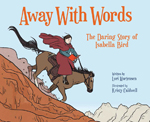 Born in 1831, Isabella Bird longed for adventure although she was sickly and in pain. On the advice of doctors for fresh air and a change of scene, Isabella set out on international travel. Digitally created illustrations depict her sometimes perilous adventure. She kept notes, some of which are quoted in the double spreads, during her journeys that included travel to Tibet. Publication of her notes in books brought her fame, a presentation to Queen Victoria, and the honor of becoming the first female member of London’s Royal Geographic Society. Back matter includes a timeline, source notes, bibliography, and an author’s note with an archival photograph of Isabella Bird in Manchu dress.
Born in 1831, Isabella Bird longed for adventure although she was sickly and in pain. On the advice of doctors for fresh air and a change of scene, Isabella set out on international travel. Digitally created illustrations depict her sometimes perilous adventure. She kept notes, some of which are quoted in the double spreads, during her journeys that included travel to Tibet. Publication of her notes in books brought her fame, a presentation to Queen Victoria, and the honor of becoming the first female member of London’s Royal Geographic Society. Back matter includes a timeline, source notes, bibliography, and an author’s note with an archival photograph of Isabella Bird in Manchu dress.
—SW
Brave Ballerina: The Story of Janet Collins. Michelle Meadows. Ill. Ebony Glenn. 2019. Henry Holt/Macmillan.
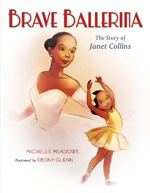 “This is the girl / who danced in the breeze / to the swoosh, swoosh, swoosh / of towering trees.” A spare text of four-line verses in a rhythmic “This is . . .” pattern and warm, expressive digital art tell the life story of Janet Collins, who was born in New Orleans, LA, in 1917. Supported by her family, Janet pursued her dream of being a dancer, even when segregation limited her opportunities for training. With her talent and perseverance, Collins went on to become the first African American prima ballerina with the Metropolitan Opera House. “This is the dancer, / bold like the sun, / a prima ballerina / in 1951.” Back matter includes an author’s note and sources.
“This is the girl / who danced in the breeze / to the swoosh, swoosh, swoosh / of towering trees.” A spare text of four-line verses in a rhythmic “This is . . .” pattern and warm, expressive digital art tell the life story of Janet Collins, who was born in New Orleans, LA, in 1917. Supported by her family, Janet pursued her dream of being a dancer, even when segregation limited her opportunities for training. With her talent and perseverance, Collins went on to become the first African American prima ballerina with the Metropolitan Opera House. “This is the dancer, / bold like the sun, / a prima ballerina / in 1951.” Back matter includes an author’s note and sources.
—CA
Fearless Mary: The True Adventure of Mary Fields, American Stagecoach Driver. Tami Charles. Ill. Claire Almon. 2019. Albert Whitman.
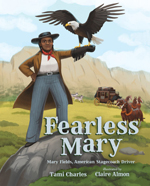 In 1895, former slave Mary Fields heads west, and arriving in Cascade, Montana, decides to apply to be a stagecoach driver for Wells Fargo, a job in which she would face the threat of robbery, the challenge of controlling powerful horses, and hardships on the trail. As a woman in her 60s, determined to make a better life for herself, she proved she could do the job as well as any man and showed her strength of spirit in protecting mail, cargo, and passengers. In an author’s note, Tami Charles tells of her inspiration, explains the challenges of her research, and clarifies the separation of fact from fiction.
In 1895, former slave Mary Fields heads west, and arriving in Cascade, Montana, decides to apply to be a stagecoach driver for Wells Fargo, a job in which she would face the threat of robbery, the challenge of controlling powerful horses, and hardships on the trail. As a woman in her 60s, determined to make a better life for herself, she proved she could do the job as well as any man and showed her strength of spirit in protecting mail, cargo, and passengers. In an author’s note, Tami Charles tells of her inspiration, explains the challenges of her research, and clarifies the separation of fact from fiction.
—SW
Planting Stories: The Life of Librarian and Storyteller Pura Belpré. Anika Aldamuy Denise. Ill. Paola Escobar. 2019. HarperCollins.
 When Pura Belpré arrived in New York City from her native San Juan, Puerto Rico, in 1921, she carried a wealth of her grandmother’s stories in her memory and heart. She found the perfect job as a bilingual assistant at the New York Public Library and, when she discovered the lack of Latino stories, began a program for families in which she told stories. Warm, richly colored, computer-generated illustrations complement the engaging text about Pura Belpre’s gift for storytelling that inspired her to write books “planting seeds in the hearts and minds of children.” Back matter includes an author’s note; selected bibliography; lists of archival collections, articles, and films; suggested reading; and notes on Belpré’s stories mentioned in the book.
When Pura Belpré arrived in New York City from her native San Juan, Puerto Rico, in 1921, she carried a wealth of her grandmother’s stories in her memory and heart. She found the perfect job as a bilingual assistant at the New York Public Library and, when she discovered the lack of Latino stories, began a program for families in which she told stories. Warm, richly colored, computer-generated illustrations complement the engaging text about Pura Belpre’s gift for storytelling that inspired her to write books “planting seeds in the hearts and minds of children.” Back matter includes an author’s note; selected bibliography; lists of archival collections, articles, and films; suggested reading; and notes on Belpré’s stories mentioned in the book.
—SW
Ages 9–11
Elvis Is King! Jonah Winter. Ill. Red Nose Studio. 2019. Schwartz & Wade/Random House.
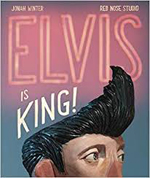 In 1952, shy, 13-year-old Elvis and his mother moved from his birthplace, Tupelo, MS, to Memphis, TN, to build a better life. With an engaging text and illustrations created with hand-crafted clay figures set in three-dimensional sets, Winter presents defining moments in the life of young Elvis, who found solace in music. He adapted songs he heard coming from the African American Church and the blues he heard in local nightclubs on a guitar his mother gave him when he was 11 years old. Finding a producer who wanted to record African American blues for a white audience, at a time when the music world was segregated, Elvis went on to become an international sensation.
In 1952, shy, 13-year-old Elvis and his mother moved from his birthplace, Tupelo, MS, to Memphis, TN, to build a better life. With an engaging text and illustrations created with hand-crafted clay figures set in three-dimensional sets, Winter presents defining moments in the life of young Elvis, who found solace in music. He adapted songs he heard coming from the African American Church and the blues he heard in local nightclubs on a guitar his mother gave him when he was 11 years old. Finding a producer who wanted to record African American blues for a white audience, at a time when the music world was segregated, Elvis went on to become an international sensation.
—SW
Let ’er Buck!: George Fletcher, the People’s Champion. Vaunda Micheaux Nelson. Ill. Gordon C. James. 2019. Carolrhoda/Lerner.
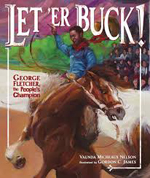 A folksy narrative and energetic oil-on-board paintings tell the story of George Fletcher (1890–1973), who became an accomplished broncobuster, but as a black cowboy was frequently banned from competitions. In 1911, at the age of 16, George finally got his chance to prove his skill as a finalist in the Saddle Bronc Championship at the Pendleton Round-Up, the biggest rodeo in the Northwest. Despite George’s show-stopping ride on a wildly bucking horse, the judges gave first prize to a white rancher. The crowd booed, and Sheriff Tillman Taylor, recognizing the injustice of the decision, raised prize money for George on the spot from the spectators who proclaimed him “People’s Champion!” Back matter includes a glossary; biographical notes on Fletcher, the other finalist, and Sheriff Taylor; and a bibliography.
A folksy narrative and energetic oil-on-board paintings tell the story of George Fletcher (1890–1973), who became an accomplished broncobuster, but as a black cowboy was frequently banned from competitions. In 1911, at the age of 16, George finally got his chance to prove his skill as a finalist in the Saddle Bronc Championship at the Pendleton Round-Up, the biggest rodeo in the Northwest. Despite George’s show-stopping ride on a wildly bucking horse, the judges gave first prize to a white rancher. The crowd booed, and Sheriff Tillman Taylor, recognizing the injustice of the decision, raised prize money for George on the spot from the spectators who proclaimed him “People’s Champion!” Back matter includes a glossary; biographical notes on Fletcher, the other finalist, and Sheriff Taylor; and a bibliography.
—CA
The Story of Olympic Swimmer Duke Kahanamoku (The Story of . . .). Ellie Crowe. Ill. Richard Waldrep. 2019. Lee & Low.
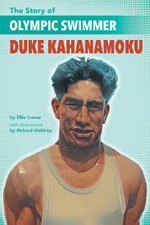 Opening with an account of Duke Kahanamoku’s incredible feat of riding out a rare 30-foot Bluebird wave for almost two miles on a wooden surfboard on Waikiki Beach in 1917, this new entry in Lee & Low’s chapter book biography series tells the life story of native Hawaiian Duke Kahanamoku (1890–1968), who grew up in Honolulu an avid swimmer. Despite racial and financial challenges, he went on to become a record-breaking Olympic swimmer and a legendary surfer. Sidebars on the history of Hawaii, the Olympics, and surfing and black-and-white illustrations add interest. Back matter includes a timeline; glossary; text, quotation and sidebar sources; and bibliography.
Opening with an account of Duke Kahanamoku’s incredible feat of riding out a rare 30-foot Bluebird wave for almost two miles on a wooden surfboard on Waikiki Beach in 1917, this new entry in Lee & Low’s chapter book biography series tells the life story of native Hawaiian Duke Kahanamoku (1890–1968), who grew up in Honolulu an avid swimmer. Despite racial and financial challenges, he went on to become a record-breaking Olympic swimmer and a legendary surfer. Sidebars on the history of Hawaii, the Olympics, and surfing and black-and-white illustrations add interest. Back matter includes a timeline; glossary; text, quotation and sidebar sources; and bibliography.
—CA
Wilma’s Way Home: The Life of Wilma Mankiller. Doreen Rappaport. Ill. Linda Kukuk. 2019. Disney-Hyperion.
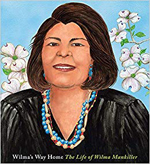 Raised in a Cherokee community by a mother of Irish Dutch lineage and a Cherokee father, Wilma Mankiller understood Gadugi, the philosophy of helping one another. The narrative, enriched with quotations from primary sources, elaborates on formative events of Mankiller’s childhood, including her family’s move to San Francisco as part of the federal government’s initiative to relocate native people to urban areas. Miserable in the city, she found companionship with other native people and in that shared experience her fervor to promote the interests of her people grew. She became the first female chief of the Cherokee Nation in the 1980s. The warm, bright hues of the watercolor illustrations depict her work in improving the lives of members of the Cherokee nation until her death in 2010. Back matter includes author’s and illustrator’s notes, a timeline of Wilma Mankiller’s life, a pronunciation guide, sources, and source notes for quotations.
Raised in a Cherokee community by a mother of Irish Dutch lineage and a Cherokee father, Wilma Mankiller understood Gadugi, the philosophy of helping one another. The narrative, enriched with quotations from primary sources, elaborates on formative events of Mankiller’s childhood, including her family’s move to San Francisco as part of the federal government’s initiative to relocate native people to urban areas. Miserable in the city, she found companionship with other native people and in that shared experience her fervor to promote the interests of her people grew. She became the first female chief of the Cherokee Nation in the 1980s. The warm, bright hues of the watercolor illustrations depict her work in improving the lives of members of the Cherokee nation until her death in 2010. Back matter includes author’s and illustrator’s notes, a timeline of Wilma Mankiller’s life, a pronunciation guide, sources, and source notes for quotations.
—SW
Ages 12–14
Dreaming in Code: Ada Byron Lovelace, Computer Pioneer. Emily Arnold McCully. 2019. Candlewick.
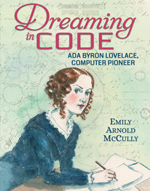 With an engaging, well-researched text, Emily Arnold McCully tells the intriguing life story of Ada Byron Lovelace (1815–1852). Fearing that Ada would grow up to have a wild imagination like her father, famous poet Lord Byron, Ada’s controlling mother, set her on a course of study of math and science. Mastering these subjects, however, did not break her spirit, and when teenager Ada met inventor Charles Babbage, who demonstrated the model of his Difference Engine, a basic calculator, she was thrilled to become his collaborator and went on to develop algorithms for Babbage’s proposed Analytical Engine. McCully clearly shows how Lovelace’s extraordinary insights and contributions to science during her short life time led to her present-day recognition as a pioneer in computer programming. Back matter includes appendices of Ada’s Notes and documents related to failed attempts for funding Babbage’s Analytical Engine, source notes, glossary, bibliography, and index.
With an engaging, well-researched text, Emily Arnold McCully tells the intriguing life story of Ada Byron Lovelace (1815–1852). Fearing that Ada would grow up to have a wild imagination like her father, famous poet Lord Byron, Ada’s controlling mother, set her on a course of study of math and science. Mastering these subjects, however, did not break her spirit, and when teenager Ada met inventor Charles Babbage, who demonstrated the model of his Difference Engine, a basic calculator, she was thrilled to become his collaborator and went on to develop algorithms for Babbage’s proposed Analytical Engine. McCully clearly shows how Lovelace’s extraordinary insights and contributions to science during her short life time led to her present-day recognition as a pioneer in computer programming. Back matter includes appendices of Ada’s Notes and documents related to failed attempts for funding Babbage’s Analytical Engine, source notes, glossary, bibliography, and index.
—CA
Never Caught, the Story of Ona Judge: George and Martha Washington’s Courageous Slave Who Dared to Run Away (Young Readers Edition). Erica Armstrong Dunbar & Kathleen Van Cleve. 2019. Aladdin/Simon & Schuster.
 The daughter of a slave on the Washingtons’ Mt. Vernon plantation, Ona grew up as a special house slave to Martha and traveled with the family in the early days of George Washington’s presidency. In 1796, when President Washington and his wife lived in Philadelphia, 22-year-old Ona Judge left their house and headed to New Hampshire and an uncertain future. She would live in New Hampshire until her death in 1848, marrying John Staines, raising children, facing poverty, and living under the shadow of capture, but always knowing she was free. This young reader’s edition of historian Erica Dunbar’s Never Caught: The Washington’s Relentless Pursuit of Their Runaway Slave, Ona Judge (2017) clearly separates fact from conjecture in telling the life story of Ona Judge.
The daughter of a slave on the Washingtons’ Mt. Vernon plantation, Ona grew up as a special house slave to Martha and traveled with the family in the early days of George Washington’s presidency. In 1796, when President Washington and his wife lived in Philadelphia, 22-year-old Ona Judge left their house and headed to New Hampshire and an uncertain future. She would live in New Hampshire until her death in 1848, marrying John Staines, raising children, facing poverty, and living under the shadow of capture, but always knowing she was free. This young reader’s edition of historian Erica Dunbar’s Never Caught: The Washington’s Relentless Pursuit of Their Runaway Slave, Ona Judge (2017) clearly separates fact from conjecture in telling the life story of Ona Judge.
—SW
Standing Up Against Hate: How Black Women in the Army Helped Change the Course of World War II. Mary Cronk Farrell. 2019. Abrams.
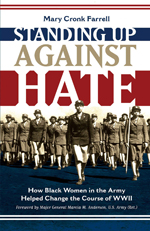 By 1942, educated African American women who were officers in the Women’s Auxiliary Army Corps trained recruits who wanted to contribute to the war effort. Farrell’s historical account, illustrated with captioned archival photographs, chronicles the role black women played in the army during World War II, fighting for jobs worthy of their training and education while facing the challenges of a segregated United States and the prejudice that a woman’s place was in the home. One interesting example recounts how, in 1944, when the allied forces in Europe had mailbags of tens of thousands of packages and letters that had not been delivered, the women took on the challenge of clearing that backlog. Back matter includes a glossary, source notes, and a bibliography.
By 1942, educated African American women who were officers in the Women’s Auxiliary Army Corps trained recruits who wanted to contribute to the war effort. Farrell’s historical account, illustrated with captioned archival photographs, chronicles the role black women played in the army during World War II, fighting for jobs worthy of their training and education while facing the challenges of a segregated United States and the prejudice that a woman’s place was in the home. One interesting example recounts how, in 1944, when the allied forces in Europe had mailbags of tens of thousands of packages and letters that had not been delivered, the women took on the challenge of clearing that backlog. Back matter includes a glossary, source notes, and a bibliography.
—SW
Ages 15+
Queen Victoria: Twenty-four Days That Changed Her Life. Lucy Worsley. 2019. St. Martin’s/Macmillan.
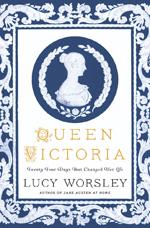 Taking the English throne at age 18 in 1837, Queen Victoria ruled England and a large fraction of the colonial world during the 19th century. Lucy Worsley incorporates descriptive details and quotations from primary sources in recounting 24 defining days in Victoria’s life as queen, wife, and mother. Worsley’s inclusion of details related to health practices and medicine of the time, government and politics, and the royal family make her biography of Queen Victoria also a history of the period. Captioned archival images and photographs in the middle of the book add information about Victoria’s personality and the time in which she lived. Back matter includes acknowledgments, sources and source notes on quotations, and an index.
Taking the English throne at age 18 in 1837, Queen Victoria ruled England and a large fraction of the colonial world during the 19th century. Lucy Worsley incorporates descriptive details and quotations from primary sources in recounting 24 defining days in Victoria’s life as queen, wife, and mother. Worsley’s inclusion of details related to health practices and medicine of the time, government and politics, and the royal family make her biography of Queen Victoria also a history of the period. Captioned archival images and photographs in the middle of the book add information about Victoria’s personality and the time in which she lived. Back matter includes acknowledgments, sources and source notes on quotations, and an index.
—SW
Sandip LeeAnne Wilson serves as professor in the School of Education and the English Department of Husson University, Bangor, Maine. Carolyn Angus is former director of the George G. Stone Center for Children's Books, Claremont Graduate University, in Claremont, California.